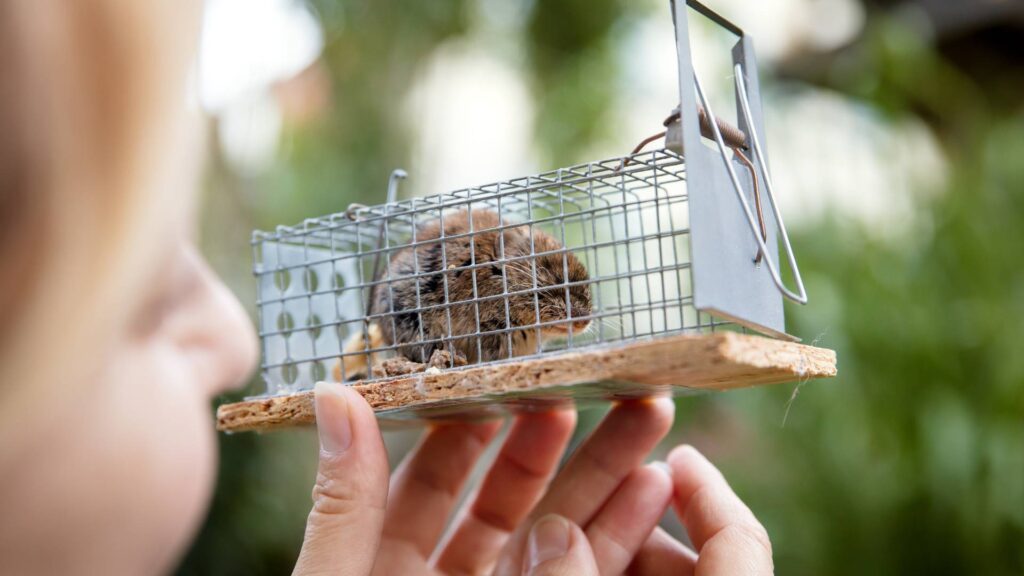Ever found yourself in the middle of a mouse menace, scratching your head over why your traps lay untouched night after night? The secret doesn’t just lie in the trap’s placement or the type; it’s all about the bait. Choosing the right bait is crucial for turning your mouse trapping endeavors from a game of luck into a guaranteed success strategy. This introduction will shed light on the importance of selecting the perfect bait and how this choice can dramatically enhance your trap’s success rates.
In the following sections, we’ll dive into what makes a bait effective, exploring various options from the classic cheese and peanut butter to less conventional, yet surprisingly effective alternatives for quick results.
Behavior and Preferences
Understanding the intricacies of mouse behavior and preferences is key to crafting an effective trapping strategy. Here’s a closer look:
Dietary Habits of Mice
- Broad Diet: Mice are omnivores that prefer grains, fruits, and seeds, but they’re not picky eaters. High-protein and high-fat foods are equally appealing.
- Effective Bait Choices: Opt for baits like peanut butter, chocolate, or pet food over traditional cheese. These align better with their natural preferences and dietary habits.
- Diversity in Bait: Utilizing a variety of foods that are high in sugar, fat, or protein can attract mice more effectively, mirroring their natural foraging behavior.
The Importance of Scent in Attracting Mice
- Scent Over Sight: Mice rely on their strong sense of smell to find food. Bait with a potent aroma can attract mice from a distance.
- Peanut Butter as Bait: Its strong, appealing scent and oily texture make peanut butter an irresistible choice for mice.
- Freshness Matters: Regularly refreshing bait ensures its scent remains potent and attractive. Stale bait loses its effectiveness over time.
By incorporating these insights into your mouse-trapping efforts, you can increase the likelihood of capturing these elusive creatures. The right bait, chosen based on their dietary habits and the critical role of scent, can turn your trap into an irresistible lure for mice. Additionally, understanding what natural scent do mice hate is equally important in deterring them from unwanted areas.
Effective Baits for Mouse Traps

Selecting the right bait is a critical step in mouse trapping. Let’s explore some top choices that have proven to be irresistible to these critters:
Peanut Butter: The Irresistible Choice
- Highly Effective: Peanut butter’s oily texture and strong scent make it one of the most attractive baits for mice.
- Proper Usage: Apply a small dab on the trap trigger. Ensure it’s enough to lure the mouse but not so much that they can eat it without setting off the trap.
Chocolate: A Sweet Temptation
- Why It Works: Chocolate’s sweet aroma can attract mice, appealing to their sweet tooth.
- Usage Tips: Use small pieces or shavings of chocolate to prevent mice from grabbing it without triggering the trap.
Seeds and Grains: Mimicking Natural Diets
- Most Appealing Options: Sunflower seeds, pumpkin seeds, and whole grains closely mimic mice’s natural food sources.
- Benefits: These baits are effective because they align with what mice are instinctively drawn to in the wild.
Fruits and Berries: Natural Sweetness
- Attractive Choices: Small pieces of apple, pear, or berries can attract mice with their natural sweetness and moisture.
- Usage: Fresh, but not overly ripe fruits are best to avoid attracting ants or other pests.
Meats and Strong-Smelling Cheeses
- Preferred Types: Small chunks of cooked meats or strong-smelling cheeses like blue cheese or gouda can be very effective.
- Why They Work: The strong odors of these foods are especially good at drawing in mice looking for a protein-rich meal.
How to Bait a Trap Effectively

Ensuring your bait is irresistible is just the start in how to attract mice to a trap. Here’s how to maximize its effectiveness:
Proper Placement
- Tempting Techniques: Place the bait on or near the trap’s trigger mechanism to ensure the mouse has to engage the trap to access the bait.
Securing the Trap
- Staying Power: For baits like peanut butter, applying directly to the trigger is sufficient. For solid baits, consider tying them down with a small piece of string or dental floss to ensure they cannot be stolen without setting off the trap.
Quantity Matters: How Much to Put On
- Just Enough: Use just enough bait to attract the mouse but not so much that they can eat without triggering the trap. A pea-sized amount of peanut butter or a small chunk of chocolate is ideal.
Troubleshooting Common Baiting Issues

Even with the best bait, there are times when mice might give your traps the cold shoulder. Here’s what you need to know to turn the tables:
Why Mice Might Be Avoiding Your Bait
Several factors could be at play if mice are bypassing your carefully laid traps. Here’s what to watch out for and how to address these issues:
- Scent Overload: Human scent on traps or bait can deter mice. Always wear gloves when setting up your trap to keep it scent-free.
- Wrong Bait Choice: If mice are ignoring your bait, it might not be appealing to them. Switch it up! Try different baits from the variety mentioned earlier to find what works best in your situation.
- Trap Shyness: Mice can be cautious of new objects in their environment. If they seem to be avoiding the trap altogether, leave it baited but unset for a few days to let them get used to its presence.
- Placement Issues: Mice tend to travel along walls. If your trap is in the open, move it closer to a wall or along a known mouse path.
When your initial baiting strategies fall short, it’s essential to adapt by observing mouse activity, experimenting with various baits or commercial attractants, and maintaining patience. Success may require time and a willingness to adjust your approach. However, if these efforts fail, consulting pest control professionals can offer specialized solutions to effectively tackle your mouse problem.
Frequently Asked Questions About What to Use as Bait for Mouse Traps
What is the best bait for a mouse trap?
The best bait for a mouse trap is peanut butter due to its strong smell and sticky texture, which ensures that mice will trigger the trap while trying to eat it. Peanut butter’s effectiveness is further enhanced when combined with other baits like chocolate or seeds, appealing to a wide range of mouse preferences.
How do you lure mice out fast?
To lure mice out quickly, use high-aroma baits like peanut butter, chocolate, or strong-smelling cheeses and place the traps along known mouse paths or near areas of high activity. Enhancing the bait’s appeal with warmth or additional scents can also increase its effectiveness, making it irresistible to mice and speeding up the trapping process.
Can you use mouse traps without bait?
Yes, you can use mouse traps without bait, but their effectiveness may decrease since the bait’s scent plays a crucial role in attracting mice. However, traps placed in strategic locations where mice are known to travel, such as along walls or near entry points, can still catch mice due to their natural exploratory behavior.


